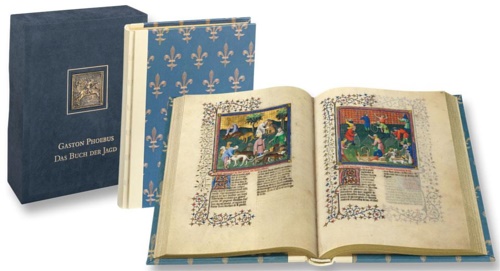 Workshop of the Bedford Master.
Gaston Phoebus - Das Buch der Jagd. Le livre de Chasse. The Master of Game.
Workshop of the Bedford Master.
Gaston Phoebus - Das Buch der Jagd. Le livre de Chasse. The Master of Game.
Pierpont Morgan Library, New York, M.1044. Luzern, Faksimile Verlag
2005,
cm.33x42,
pp.256, 87 grandi scene dipinte, 126 grandi capilettera miniati in oro.
Rilegatura come dall'originale, in tutta seta con gigli di Francia in oro.
Edizione limitata in 980 esemplari. Commentario in Francese e tedesco di Yves Christe.; D’Escayrac-Lauture, A.; William Voelkle; Francois Avril.
Con Commentario.
This work not only represents the most famous record of medieval hunting, but also is an impressive documentation of natural history. The work was made around 1387 and is one of the finest manuscripts ever made in the Middle Ages. Shining gold and glowing colours testify to the high quality of work being produced in the Bedford Masters workshop.
The most celebrated hunting book of medieval times: Gaston III, count of Foix and Béarn in the south of France, wrote his “Livre de chasse”, or Master of Game, in the years 1387–1389. This work not only represents the most famous record of medieval hunting, but may also be considered as one of the most interesting testimonies to the cultural history of its time.
Gaston de Foix, because of his bright blond hair also called “Phoebus” after the Greek sun god, describes in his four-part hunting book not only the then common forms of hunting, but also presents an impressive natural history, which – long before the times of the empiric sciences – was based on the extensive observation of different species and used as a text book well into the 19th century.
The Facsimile:Gaston Phoebus - The Master of Game is published as a faithful Fine Art Facsimile limited edition in the format of 38.5 x 28.6 cm. The fact that this edition is strictly limited to only 980 hand-numbered copies makes the Master of Game an exclusive masterpiece of book art world-wide and an item with rarity value. 87 vivid miniatures, richly ornate with gold leaf and brush gold, 126 imaginative large initials, as well as abundant scrollwork made of shining golden, red and blue foliage make the 128 folios a perfect background for the whole splendour of French bibliophile collection in the Gothic period. Written in a wonderful, if not perfect textura script, the French text has remained clearly legible to this day. In their commentary, Yves Christe (Geneva), Antoine d'Escayrac-Lauture (Kasteel Westerlo), William Voelkle (New York) and Francois Avril (Paris) present a comprehensive historic and art-historic analysis of the work. Thanks to the complete transcription and translation of the French text, today's readers may also immerse themselves in the aristocratic culture of the Middle Ages. Both the facsimile and the commentary volumes are presented in a protective case of acrylic glass.
Binding: The binding of the Fine Art Facsimile edition is modelled on a blue silk binding from the library of King Louis XII. The fine silk was especially woven for this purpose and embroidered with golden lilies, the emblem of the French royal dynasty. Last but not least, the noble impression of the volume is perfected by the use of fine parchment with which the bookbinder covers the spine.
EAN:
9783856721008
Nuovo